Water drop wort, Water celery
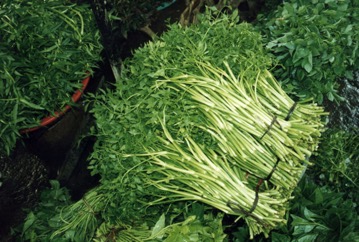
A tropical plant. It mostly occurs between 700 and 2800 m altitude in the tropics. But it also grows down to the coast where it is becoming more popular. It grows in wetlands. It also grows in China, Indonesia and other Asian countries. In Northeastern India it grows between 1,900-3,000 m above sea level. It grows best between 15° to 25°C. It suits hardiness zones 9-12. Bontoc. At MARDI. In Yunnan. In Sichuan.
Also known as:
Aguhama ao, 'ap'apun, Andum, Babon, Bacharongi, Bambung, Barn, Beizhe, Can com, Can nuoc, Can ong, Chin tsai, Chu kuei, Cogur nogugoa, Dini, Ekhrou, Ependung, Gai weng, Iyb-taziy, Kebunamul, Komprek, Minari, Nakuri, O shuo wu, Ouge, Pa ne, Paa-a-daw, Pakcheelom, Pak chi lawm, Pak chinam, Palailai, Pampung, Pan tarori, Pan-tusari, Pangpung, Phak an, Phak chee lom, Phak shi naam, Phak si sang, Piopo, Rau can, Rau can nuoc, Saya, Seladren, Selom, Seri, Shan qin cai, Shelum, Shui Qin, Shuiqincai, Sui kan, Szhing-hru, Tespong, Thrai-vu, Wo guo wo luo, Za-lae, Zeemtsi, Zen axi, Zha suo
Synonyms
- Oenanthe stolonifera Wall.
- Oenanthe benghalensis Benth. & Hook.f.
- Oenanthe linearis Wall. ex DC.
- Oenanthe stolonifera Wall. ex DC.
- Oenanthe japonica Miquel
- Sium javanicum Blume
- and others
Edible Portion
- Leaves, Seeds, Spice, Vegetable, Roots
Where does Water drop wort grow?
Found in: Asia, Australia, Bhutan, Cambodia, China, East Timor, Fiji, Hawaii, Himalayas, India, Indochina, Indonesia, Japan, Korea, Laos, Malaysia, Myanmar, Nepal, North America, Northeastern India, Pacific, Pakistan, Papua New Guinea, PNG, Philippines, Russia, SE Asia, Taiwan, Thailand, Timor-Leste, United States, Vietnam, West Papua
Notes: Chemical composition: Protein = 1.51%. Fat = 0.28%. Carbohydrate = 2.47%. Ash = 1.4% It has 24.2 mg per 100 g dry weight and 14.7 mg fresh weight of alpha-tocopherol (Vitamin E). Water dropwort Oenanthe javanica The plant. This plant is a hollow stemmed creeping green leafy vegetable. The stem if often up to 100 cm long and normally lies along the ground and turns up near the tip. The leaves are finely divided like carrot tops but the size, shape and colour of the leaves can vary quite a bit, even on the one plant. The leaves often have leaf sheaths which wrap around the stem. The flowers occur at the ends of the branches and are a group of small white flowers. Where does the plant grow ? In Papua New Guinea this is one of the commonest green leafy vegetables of the Highland areas. In recent times it has been introduced into coastal areas and still grows wuite well. In the highland areas it is common in gardens up to 2600 metres altitude and has been seen growing up to 3400 m altitude. It normally grows near creeks or in wet or damp patches in gardens. The hollow stemmed branches can actually float on water and the plants seem to thrive along drains and ditches. This plant is also grown as food in several other countries. It is common in Indonesia and Malaysia and is also grown in India, Vietnam, China, Taiwan and a number of other South East Asian and Pacific countries. It is a traditional vegetable with ceremonial importance in Japan. Names Because the leaf shape and appearance of this plant can vary considerably, it has had some different scientific names. The correct name is Oenanthe javanica and it was given this name by a scientists called De Candolle in 1830. The other most commonly used scientific name has been Oenanthe stolonifera but as the two plants are the same this name has now been replaced. It has no commonly accepted English or Tok Pisin name. Names such as water celery and water dropwort have been used in English. Because several other Oenanthe spp plants are very poisonous, it is probably not a good idea to just use “oenanthe” as the name and run the risk of confusing a good vegetable with other poisonous plants. It has many different Tok Ples names. Growing water dropwort. This plant often grows wild. These self sown plants are not as tasty as the cultivated types but they are eaten. The plant is also grown in gardens. It is planted by using cuttings. Often 5 or 6 cutings are planted in a hole made with a digging stick. In moist soil the plants establish quickly and easily. It is also possible to grow the plants by seeds, but these are rarely used in PNG. Water dropwort as food. The leaves and young tips of the plant are often eaten raw or cooked. The amount of different nutrients in a 100g sample of this food is shown in this table. moisture energy protein calcium iron proVitA provitC 90.6% 28cals 1.8g 113mg 3mg 2190µg 14 mg A chemical called myristicin has been shown to occur in water dropwort. Because of this, it may not be good to eat large amounts of this vegetable.
Status: It is a commercially cultivated vegetable. Shoots are sold in local markets. A common green in most highland areas of Papua New Guinea.
Growing Water drop wort, Water celery
Cultivation: This plant often grows wild. These self sown plants are not as tasty as the cultivated types but they are eaten. The plant is also grown in gardens. It is planted by using cuttings. Often 5 or 6 cuttings are planted in a hole made with a digging stick. In moist soil the plants establish quickly and easily. It is also possible to grow the plants by seeds, but these are rarely used in Papua New Guinea. The leaves and young tips of the plant are often eaten raw or cooked.
Edible Uses: The plant is often eaten raw or cooked. They are boiled or steamed. The leaves are used in soups and salads and with chicken. CAUTION Although not known to contain the very poisonous oenanthotoxin it contains a hallucinatory drug myristicin.
Nutrition Info
per 100g edible portion| Edible Part | Energy (kcal) | Protein (g) | Iron (mg) | Vitamin A (ug) | Vitamin c (mg) | Zinc (mg) | % Water |
|---|---|---|---|---|---|---|---|
| Leaves | 28 | 1.8 | 3 | 40 | 6 | 0.5 | 90.6 |
Water drop wort, Water celery Photos

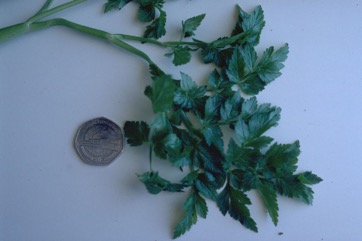
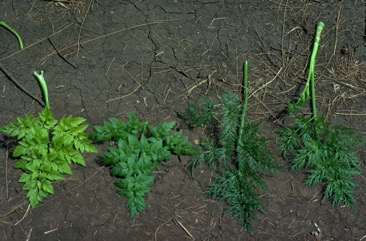
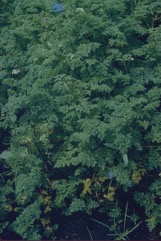
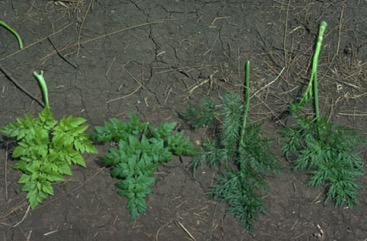
References
Oenanthe javanica references
Altschul, S.V.R., 1973, Drugs and Foods from Little-known Plants. Notes in Harvard University Herbaria. Harvard Univ. Press. Massachusetts. no. 3153
Ambasta, S.P. (Ed.), 2000, The Useful Plants of India. CSIR India. p 406
Anderson, E. F., 1993, Plants and people of the Golden Triangle. Dioscorides Press. p 216
Angami, A., et al, 2006, Status and potential of wild edible plants of Arunachal Pradesh. Indian Journal of Traditional Knowledge 5(4) October 2006, pp 541-550
Arora, R. K., 2014, Diversity in Underutilized Plant Species - An Asia-Pacific Perspective. Bioversity International. p 43
Backer,C.A.,& Brink,B van den, 1968, Flora of Java 3 vols. p177
Bailey, , 1900, Oenanthe stolonifera Queensland Fl.,2 p726
Bell, C.R., & Lincoln, C.,1957, Chromosome numbers in Umbelliferae. Amer. Journ. Bot. 44(7):565-572 Illus.
Blume, , 1826, Sium javanicum Blume Bijdr.Fl.Nederl. Ind.15:881
Bodner, C. C. and Gereau, R. E., 1988, A Contribution to Bontoc Ethnobotany. Economic Botany, 43(2): 307-369
Bohlmann, F., Zolero,C., Trenel, J., Haenel, P., and Grenz, M., 1971, Polyacetylene compounds 194. On additional polyynes from Umbelliferae. Chem. Ber. 104(4):1322-1328 Illus.
Borrell, O.W., 1989, An Annotated Checklist of the Flora of Kairiru Island, New Guinea. Marcellin College, Victoria Australia. p 142
Brickell, C. (Ed.), 1999, The Royal Horticultural Society A-Z Encyclopedia of Garden Plants. Convent Garden Books. p 717
Bunnemeyer, , 1918, De Tropische Natuur, 7 p 70
Burkill, I.H., 1935, Dictionary of Economic Products of the Malay Peninsula. Govt.of the Straits Settlements p 1604
Buwalda, P., 1936, Blumea 2:194-
Buwalda, P., 1949, Flora Malesiana 1,4(2) p 135.
Buwalda,P.,1951, Notes on New Guinea Umbelliferae. Journ. Arnold. Arb. 32(1):59-66 Illus.
Cao, Y., et al, 2020, Ethnobotanical study on wild edible plants used by three trans-boundary ethnic groups in Jiangcheng County, Pu’er, Southwest China. Journal of Ethnobiology and Ethnomedicine (2020) 16:66
Chen, B. & Qiu, Z., Consumer's Attitudes towards Edible Wild Plants, Ishikawa Prefecture, Japan. p 24 www.hindawi.com/journals/ijfr/aip/872413.pdf
Chermezon, , 1923, in Lemonte,Fl.Gen.Indo-Chine,2, p1147.
Ching, L. S. & Mohamed, S., 2001, Alpha-Tocopherol Content in 62 Edible Tropical Plants. J. Agric. Food Chem. 2001, 49, 3101−3105
Clarke, E.G.C., Kidder, D.E., & Robertson W.D., 1949, The isolation of the toxic principle of Oenanthe crocata. Journ. Pharm. and Pharmacol. 1(6):377-381.
Clarke, C.B.,1879 in Hooker, J.D., Fl.Br. In. Vol.2, p 696.
Combes, R., 1947, The mechanism of action of the medium on aquatic plants. The temperature factor. Rev. Gen. Bot. 56(642):249-270. Illus.
Cruz-Garcia, G. S., & Price, L. L., 2011, Ethnobotanical investigation of 'wild' food plants used by rice farmers in Kalasin, Northeast Thailand. Journal of Ethnobiology and Ethnomedicine 7:33
Cundall, P., (ed.), 2004, Gardening Australia: flora: the gardener's bible. ABC Books. p 947
Dangol, D. R., 2002, Economic uses of forest plant resources in western Chitwan, Nepal. Banko Janakari, 12(2): 56-64
Dangol, D. R. et al, 2017, Wild Edible Plants in Nepal. Proceedings of 2nd National Workshop on CUAOGR, 2017. (Also as Oenanthe stolonifera)
De Candolle, , 1930, Oenanthe stolonifera D.C. Prodr.4, 138.
De Clercq, , 1909, Nieuw Platk. Woordenb. p 292 no.2481.
De Clercq, , 1927(2nd ed.) Nieuw Plantk. Woordenb. p162 no.2884.
Devi, O.S., P. Komor & D. Das, 2010, A checklist of traditional edible bio-resources from Ima markets of Imphal Valley, Manipur, India. Journal of Threatened Taxa 2(11): 1291-1296
Dobriyal, M. J. R. & Dobriyal, R., 2014, Non Wood Forest Produce an Option for Ethnic Food and Nutritional Security in India. Int. J. of Usuf. Mngt. 15(1):17-37
Duke and Ayensu, 1985,
Dunn, , 1903, Oenanthe sinensis Journ.Linn. Soc.XXXV p 496
Edgeworth, , , Trans.Linn. Soc. XX, 53.
Eiadthong, W., et al, 2010, Management of the Emerald Triangle Protected Forests Complex. Botanical Consultant Technical Report. p 51
Ethnobotany of Karen in Khun Tuen Noi Chiang Mai. http://khuntuennoi.myspecies
Facciola, S., 1998, Cornucopia 2: a Source Book of Edible Plants. Kampong Publications, p 20
Filet, ,1888, Plantk.Woordenb. p 290 no.8587
Food Composition Tables for use in East Asia FAO http://www.fao.org/infoods/directory No. 794 (As Oenanthe stolonifera)
French, B.R., 1986, Food Plants of Papua New Guinea, A Compendium. Asia Pacific Science Foundation p 58
Fukuoka-ken, , 1946, Edible Wild Plants.
Gangwar, A. K. & Ramakrishnan, P. S., 1990, Ethnobotanical Notes on Some Tribes of Arunachal Pradesh, Northeastern India. Economic Botany, Vol. 44, No. 1 pp. 94-105
Geda, A., M. Bokadia, and R.K. Thappa. 1979, Chemical Investigations of Oenanthe stolonifera Wall. Indian Perfumer. 23:63-64.
Geng, Y., et al, 2016, Traditional knowledge and its transmission of wild edibles used by the Naxi in Baidi Village, northwest Yunnan province. Journal of Ethnobiology and Ethnomedicine. 12:10
Georgeson, ,1891, Amer. Gard. 653.
Ghorbani, A., et al, 2012, A comparison of the wild food plant use knowledge of ethnic minorities in Naban River Watershed Nature Reserve, Yunnan, SW China. Journal of Ethnobiology and Ethnomedicine; 8:17
Hale, P.R.& Williams, B.D.,(eds), 1977, Liklik Buk p20. Melanesian Council of Churches.
Handel-Mazzetti, , 1933, Symb.Sin. VII p 722.
Harborne, J.B., Heywood,V.H. & Williams, C.A., 1969, Distribution of myristicin in seeds of the Umbelliferae. Phytochemistry 8(8):1729-1732. Illus.
Hedrick,U.P.(ed),1919, Sturtevant's Edible Plants of the World (1972 reprint) p 391. (446 As Oenanthe stolonifera)
Herklots, 1972, Water dropwart. In Vegetables of S.E.Asia.
Heyne, ,1927 (2nd ed,) Nutt. Planten p 1215
Hibbert, M., 2002, The Aussie Plant Finder 2002, Florilegium. p 213
Hide, R., et al, 1979, A checklist of some plants in the territory of the Sinasina Nimai (Simbai Province, Papua New Guinea), with notes on their uses. Department Anthropology, University of Aukland
Hu, Shiu-ying, 2005, Food Plants of China. The Chinese University Press. p 600
Hwang, H., et al, 2013, A Study on the Flora of 15 Islands in the Western Sea of Jeollanamdo Province, Korea. Journal of Asia-Pacific Biodiversity Vol. 6, No. 2 281-310
Jain et al, 2011, Dietary Use and Conservation Concern of Edible Wetland Plants at Indo-Burma Hotspot: A Case Study from Northeast India. Journal of Ethnobiology and Ethnomedicine 7:29 p 7
Japanese International Research Centre for Agricultural Science www.jircas.affrc.go.jp/project/value_addition/Vegetables
Jiwajinda, S., et al, 2002, Suppressive Effects of Edible Thai Plants on Superoxide and Nitric Oxide Generation. Asian Pacific Journal of Cancer Prevention, Vol 3, 2002 (As Oenanthe stolonifera)
Johnson, N., 2002, Environmental Change in northern Thailand: Impact on Wild Edible Plant Availability. Ecology of Food and Nutrition, 41: 5, 373-399
Joshi, N., et al, 2007, Traditional neglected vegetables of Nepal: Their sustainable utilization for meeting human needs. Tropentag 2007. Conference on International Agricultural Research for Development.
Joshi, N. & Siwakoti, M., 2012, Wild Vegetables Used by Local Community of Makawanpur District and Their Contribution to Food Security and Income Generation. Nepal Journal of Science and Technology Vol. 13, No. 1 (2012) 59-66
Kachenchart, B., et al, 2008, Phenology of Edible Plants at Sakaerat Forest. In Proceedings of the FORTROP II: Tropical Forestry Change in a Changing World. Bangkok, Thailand.
Kang, Y., et al, 2012, Wild food plants and wild edible fungi in two valleys on the Qinling Mountains (Shaanxi, central China) Journal of Ethnobiology and Ethnomedicine; 9:26
Kays, S. J., and Dias, J. C. S., 1995, Common Names of Commercially Cultivated Vegetables of the World in 15 languages. Economic Botany, Vol. 49, No. 2, pp. 115-152
Konsam, S., et al, 2016, Assessment of wild leafy vegetables traditionally consumed by the ethnic communities of Manipur, northeast India. Journal of Ethnobiology and Ethnomedicine, 12:9
Koorders, , 1912, Exkflora von Java, II p 729.
Kuo, W. H. J., (Ed.) Taiwan's Ethnobotanical Database (1900-2000), http://tk.agron.ntu.edu.tw/ethnobot/DB1.htm
Kurono, G. & Yamaguchi, I., 1952, Ann. Rep. Fac. Pharm. Kanazama Univ., 2,1.
Kurz, ,1877, Journ.As.Soc. pt.ii, 115
Kwon, D., Yoon, S., Carter, O., and Bailey, GS. (2006). Antioxidant and antigenotoxic activities of Angelica keiskei, Oenanthe javanica and Brassica oleracea in the Salmonella mutagenicity assay and in HCT116 human colon cancer cells. BioFactors, 26(4), 231-44.
Larkcom, J., 1991, Oriental Vegetables, John Murray, London, p 131
Lembogi Biologi Nasional, 1980, Sayur-sayuran. Balai Pustaka, Jakarta. p 112
Li, 1973,
Lim, T. K., 2015, Edible Medicinal and Non Medicinal Plants. Volume 9, Modified Stems, Roots, Bulbs. Springer p 59
Lindl. , , , Dasyloma latifolium in Royle Ill. 332.
Liu,Chao,& Chuang,1961, Quart.Journ.Taiwan Mus. 14(1-2):32 pl 9 f21 pl 8 f9
Liu, T.S. & Kao, M.J., 1977, Umbelliferae in Flora Taiwan p 957.
Luo, B., et al, 2019, Wild edible plants collected by Hani from terraced rice paddy agroecosystem in Honghe Prefecture, Yunnan, China. Journal of Ethnobiology and Ethnomedicine 15:56
Maisuthisakul, P., 2012, Phenolic Constituents and Antioxidant Properties of some Thai Plants. Chp. 9 in Book Phytochemicals - A Global Perspective of Their Role in Nutrition and Health (As Oenanthe stolonifera)
Miean, K. H. & Mohamed, S., 2001, Flavonoid (Myricetin, Quercetin, Kaempferol, Luteolin, and Apigenin) Content of Edible Tropical Plants. Journal of Agricultural and Food Chemistry. 49:3016-3112
Makino, , 1962, Makino's New Illustrated Flora of Japan. Hokuryukan Co.,Tokyo. p 440
Massal, E. and Barrau, J., 1973, Food Plants of the South Sea Islands. SPC Technical Paper No 94. Noumea, New Caledonia. p 35
Matsumura and Hayata, , 1906, Enum Pl. Formosa p172.
Meyer,W.,1949, The Katham moorland, a refuge in the peat district of West Netherlands. Levande Natuur 52(7):121-128 Illus. (re Oenanthe lachenalii).
Migo, H.,1942, New or noteworthy plants from China I, Bot. Mag. (Tokyo) 56:265-270.
Milliken, W., 2,000, Ethnobotany of the Yali of West Papua. Royal Botanic Garden, Edinburgh (near Baliem)
Miquel, F.A.W., , Dasyloma sub-bipinnatum in Ann,Mus.Lugd. Bat.III, 59
Miquel, F.A.W., 1860, Oenanthe javanica and Dasyloma laciniatum Miqu. Fl.Ind. Bat. 1(1),741.
Mot So Rau Dai an Duoc O Vietnam. Wild edible Vegetables. Ha Noi 1994, p 40
Murtem, G. & Chaudhrey, P., 2016, An ethnobotanical note on wild edible plants of Upper Eastern Himalaya, India. Brazilian Journal of Biological Sciences, 2016, v. 3, no. 5, p. 63-81
Ochse, , 1925, Tropische Groenten p190.
Ochse, J.J., 1931, Oenanthe javanica (Bl.)A.DC. in Vegetables of Dutch East Indies. G.Koeff and Co. Batavia p 717
Ogle, B. M., et al, 2003, Food, Feed or Medicine: The Multiple Functions of Edible Wild Plants in Vietnam. Economic Botany 57(1): 103-117
Ong, H. G., et al, 2015, Ethnobotany of the wild edible plants gathered in Ulleung Island, South Korea. Genet Resourc Crop Evol. Springer
Pagag, K. & Borthakur, S.K., 2012, Wild edible wetland plants from Lakhimpur district of Assam, India. Pleione 6(2): 322 - 327
Pemberton, R. W. & Lee, N. S., 1996, Wild Food Plants in South Korea: Market Presence, New Crops, and Exports to the United States. Economic Botany, Vol. 50, No. 1, pp. 57-70
Perry, 1980,
Pfoze, N. L., et al, 2012, Assessment of Local Dependency on Selected Wild Edible Plants and fruits from Senapati district, Manipur, Northeast India. Ethnobotany Research & Applications 10:357-367 (As Oenanthe stolonifera)
Pfoze, N. L., et al, 2012, Survey and assessment of floral diversity on wild edible plants from Senapati district of Manipur, Northeast India. Journal or Biodiversity and Environmental Sciences. 1(6):50-52
Plants for a Future database, The Field, Penpol, Lostwithiel, Cornwall, PL22 0NG, UK. http://www.scs.leeds.ac.uk/pfaf/
Prodr. 4:138. 1830
PROSEA handbook Volume 13 Spices. p 278
READ (As Oenanth stolonifer)
Ridley, ,1922, Flora Mal. Penins. I, p 871.
Romanowski, N., 2007, Edible Water Gardens. Hyland House. p 65
Roxburgh, , , Phellandrium stoloniferum Hort.Bang.21
Sachula, et al, 2020, Wild edible plants collected and consumed by the locals in Daqinggou, Inner Mongolia, China. Journal of Ethnobiology and Ethnomedicine (2020) 16:60
Sang, D. T., & Mizoue, K. O. N., 2012, Use of Edible Forest Plants among Indigenous Ethnic Minorities in Cat Tien Biosphere Reserve, Vietnam. Asian Journal of Biodiversity Vol. 3 (1), p 23-49
Sato,Tsuguo, Yoshiharu Kobayashi & Mitsuo Takahashi, 1972, Studies in the components of Oenanthe stoloniferum DC. Yakugaku Zasshi 92(10):1295-1297 Illus.
Schneider, E., 2001, Vegetables from Amaranth to Zucchini: The essential reference. HarperCollins. p 691
Sharma, S.K. and V. P. Singh, 1979, Antifungal study of the essential oil of Oenanthe javanica Blume, DC. Indian Drugs 16:289-291
Sharma, S.K. and V. P. Singh, 1980, Biochemical study of a medicinal plant Oenanthe javanica (Blume) DC. Volatile oil and fixed oil. Indian Drugs & Pharm. Industr. 15:25-26.
Sharma, S.K., V. P. Singh, and R.R. Bhagwat, 1980, In vitro antibacterial effect of the essential oil of Oenanthe javanica (Blume) DC. Indian J. Med. Res 71:149-151.
Shin, T., et al, 2018, Traditional knowledge of wild edible plants with special emphasis on medicinal uses in Southern Shan State, Myanmar. Journal of Ethnobiology and Ethnomedicine (2018) 14:48
Shulgin, A.T., 1966, Possible implications of myristicin as a psychotropic substance. Nature Vol 210 p 380.
Sillitoe, P. 1995, An Ethnobotanical Account of the Plant Resources of the Wola Region, Southern Highlands Province, Papua New Guinea. J. Ethnobiol. 15(2): 201-235
Singh, H.B., Arora R.K.,1978, Wild edible Plants of India. Indian Council of Agricultural Research, New Delhi. p 31
Song, M., et al, 2013, Traditional knowledge of wild edible plants in Jeju Island, Korea. Indian Journal of Traditional Knowledge. 12(2) pp 177-194
Srichaiwong, P., et al, 2014, A Study of the Biodiversity of Natural Food Production to Support Community Upstream of Chi Basin, Thailand. Asian Social Science 10 (2):
Srivastava, R. C., 2010, Traditional knowledge of Nyishi (Daffla) tribe of Arunachal Pradesh. Indian Journal of Traditional Knowledge. 9(1):26-37
Staples, G.W. and Herbst, D.R., 2005, A tropical Garden Flora. Bishop Museum Press, Honolulu, Hawaii. p 116
Stephens, K.M., & Dowling, R.M., 2002, Wetland Plants of Queensland. A field guide. CSIRO p 4
Tanaka, T., 1976, Oenanthe javanica DC. in Tanaka's Cyclopedia of Edible Plants of the World. p 504
Tanaka, Y. & Van Ke, N., 2007, Edible Wild Plants of Vietnam: The bountiful garden. Orchid books. p 26
Terra, G.J.A., 1973, Tropical Vegetables. p 64 Communication 54e Royal Tropical Institute, Amsterdam
The Pacific Islands Food Composition Tables http://www.fao.org/docrep No C061
Thothathri, K., & Pal, G.D., 1987, Further Contribution to the Ethnobotany of Subansiri District, Aranchal Pradesh. J. Econ. Tax. Bot. Vol. 10 No. 1 pp 149-157
Tsering, J., et al, 2017, Ethnobotanical appraisal on wild edible plants used by the Monpa community of Arunchal Pradesh. Indian Journal of Traditional Knowledge. Vol 16(4), October 2017, pp 626-637
Tsherig, K., 2012, Edible Wild Plants of Bhutan and their contribution to Food and Nutrition Security. Ministry of Ag. and Forests, Bhutan. www.fao.org
Turcz, , 1849, Cyssopetalum javanum Bull. Soc. Mat. Mosc. pt ii, 25
Uphof, J.S.T., 1968, (2nd ed) Dictionary of Economic Plants. Stechert-Hafner Service Agency, New York. p 367.
USDA, ARS, National Genetic Resources Program. Germplasm Resources Information Network - (GRIN). [Online Database] National Germplasm Resources Laboratory, Beltsville, Maryland. Available: www.ars-grin.gov/cgi-bin/npgs/html/econ.pl (10 April 2000)
Wall, , 1828-1849, Oenanthe stolonifera: Oenanthe linearis Wall.Cat. 585, 586
Wang, J. et al, 2013, A Study on the Utilization of Wild Plants for Food in Liangshan Yi Autonomous Prefecture. Plant Diversity and Resources. 35(4): 416-471
Warris,H.,1959, Neomorphosis in seed plants induced by amino acids I, Oenanthe aquatica Physiol Plantarum 12(4):753-766 Illus
Watanabe, I., T. Yanai, S. Tamogami, M. Nakamura, and T, Habu. 1979, Volatile components of seri (Oenanthe stolonifera DC). V11 International Congress of Essential Oils, October 7-11, 1977, Kyoto, Japan p442-445
Woodward, P., 2000, Asian Herbs and Vegetables. Hyland House. p 104
Wright,H.,1959, Icones Plantarum Indiae Orientalis Ic t 571
Yashiroda, 1968, Water dropwort (Oenanthe stolonifera) Bulletin 60 Hawaii Experiment Station p 30.
World Checklist of Useful Plant Species 2020. Royal Botanic Gardens, Kew
Wujisguleng, W., & Khasbagen. K., 2010, An integrated assessment of wild vegetable resources in Inner Mongolian Autonomous Region, China. Journal of Ethnobiology and Ethnomedicine 6:34
Xu, You-Kai, et al, 2004, Wild Vegetable Resources and Market Survey in Xishuangbanna, Southwest China. Economic Botany. 58(4): 647-667.
Zhang, Y., et al, 2014, Diversity of wetland plants used traditionally in China: a literature review. Journal of Ethnobiology and Ethnomedicine. 10:72